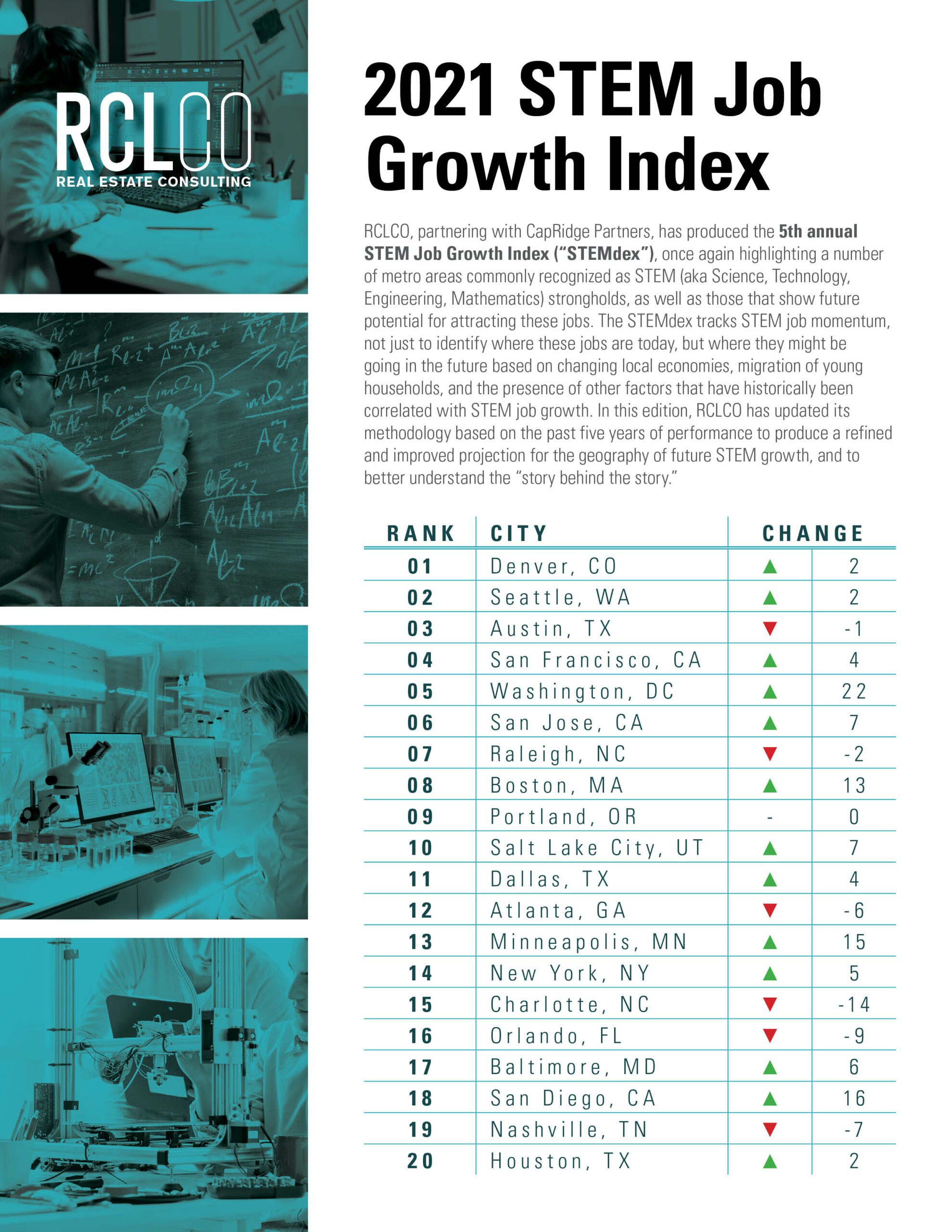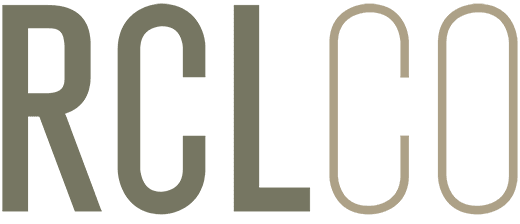
October 25, 2021
RCLCO, partnering with CapRidge Partners, has produced the 5th annual STEM Job Growth Index (“STEMdex”), once again highlighting several metro areas commonly recognized as STEM (aka Science, Technology, Engineering, Mathematics) strongholds, as well as those that show future potential for attracting these jobs. U.S. STEM workers earn higher wages than their non-STEM peers, have a broad impact on the economy, and STEM industries contribute heavily to U.S. GDP. Thus understanding where STEM activity is greatest helps to identify areas of economic growth and investment opportunity. The STEMdex tracks STEM job momentum, not just to identify where these jobs are today, but where they might be going in the future based on changing local economies, migration of young households, and the presence of other factors that have historically been correlated with STEM job growth. In this edition, RCLCO has updated its methodology based on the past five years of performance to produce a refined and improved projection for the geography of future STEM growth, and to better understand the “story behind the story.”
The Importance of STEM
As we approach the end of 2021 with a multi-year global health crisis in the form of the COVID-19 pandemic finally showing signs of abatement, it is an appropriate time to once again turn our focus toward the industry sector which had a meaningful impact on the lives of all Americans over the past two years. STEM jobs (an acronym for Science, Technology, Engineering, and Mathematics) have certainly played a critical role in helping to counter and/or live with the impacts of COVID-19. Between 2005 and 2015, STEM employment grew by nearly 25% – over five times more than non-STEM employment over the same period. Throughout the 2020s, the U.S. Bureau of Labor Statistics projects more than 1,000,000 STEM jobs will have been added, representing nearly 11% growth compared to less than 8% for all other industries.
As science and technology become increasingly important components of our lives, STEM jobs and their higher than average wages ($89,780 vs $40,020) and employment rates more resistant to economic shocks (unemployment in STEM jobs peaked at 9% in 2020 vs 16% for non-stem jobs) are likely to continue to attract a diverse range of labor. This is certain to have significant implications for both economic development and real estate.
About 47% of STEM jobs are explicitly computer-related (projected to grow to 49% by 2029), including computer and information systems management, programmers, software developers, and other computer support specialists. Mathematics, engineering, life, and physical sciences, and social science occupations comprise the other half of STEM jobs.
Composition of STEM Jobs by Industry; United States; 2019
Source: U.S. Census Bureau
The fastest-growing STEM jobs over the last five years are in Computer User Support, Industrial Engineering, Information Security, and Civil Engineer; each adding over 35,000 jobs between 2015 and 2019. Over the coming decade, the Bureau of Labor Statistics projects the strongest growth to concentrate in Computers & Mathematics, Architecture and Engineering, and Life, Physical & Social Science. However, it is important to note that these projections have also been impacted by the COVID-19 pandemic, with Life, Physical, and Social Science jobs seeing a more significant bump in projected future job growth. This category includes jobs like medical scientists and epidemiologists, two professions that have received well-earned attention in light of their impacts during the COVID-19 pandemic.
For the past five years, RCLCO has released the STEM Job Growth Index (“STEMdex”), as a tool to not just highlight the top locations for STEM employment today, but to estimate where STEM employment growth is most likely to be most pronounced in future years. Understanding this economic momentum allows us to examine the important jobs noted above, and consider the impact they might have on the future of real estate and economic development in cities across the country.

New entrants into the top 20 MSA’s include Washington D.C., Boston, Minneapolis, Baltimore, San Diego, and Houston while Detroit, Phoenix, Indianapolis, Tampa, Las Vegas, and San Antonio are no longer in the top 20. The STEMdex rewards positive economic factors more than it punishes negative factors and cities falling out of the top twenty may have remained stable over the last year and will likely continue to enjoy strong growth. Denver has attained the top spot for the first time in the history of the STEMdex after a steady ascent over the preceding three years (8th in 2018, 5th in 2019, and 3rd in 2020). Cities with strong Location Quotients or LQs that are steadily growing (Denver, Austin, and Baltimore) will likely remain within the index in future years along with cities enjoying strong millennial migration (Orlando and Nashville).
There is significant economic activity already underway in the cities cited in the Top 20. The Colorado Economic Council has committed more than $10 million in tax credits to stimulate additional growth in technology and technology education while medical research firm Adaptive Biotechnologies has announced a new 100,000 square foot headquarters in Seattle to continue their research into immune system clinical products. Alphabet/Google has announced plans to more than double their office footprint in Downtown Austin, and Tesla recently announced its relocation to Austin, TX. Amazon also continues to expand its new HQ2 in the Washington DC MSA. In the meantime, Google is purchasing $2.1 billion worth of office space on Manhattan’s West Side all while developing 7.3 million square feet of office in San Jose despite providing much of their workforce the opportunity to work remotely permanently.
Understanding the 2021 STEM Job Growth Index (STEMdex)
With five years of data available to evaluate, the 2021 STEMdex has been revised and expanded. As in past years, RCLCO analyzed 25 different metrics across four broader categories: STEM Trends/Other Economic Factors, Workforce Quality, Quality of Life, and Business Climate. The relative weighting for these categories has been re-calibrated to more appropriately correlate with actual STEM job locations, and the Index was expanded to include all 50 of the most populous Metropolitan Statistical Areas (MSAs) in the United States.
A key consideration for where future STEM momentum might exist is based on the Location Quotient (“LQ”) of STEM jobs today. The Location Quotient is a comparison of the concentration of jobs in a specific industry (or in this case industries) within one metropolitan area relative to the concentration in the country overall. For example, the LQ of STEM jobs in the San Jose MSA is 3.25 relative to the US economy indicating that the share of STEM jobs in San Jose is over 3 times higher than in the broader US Economy. RCLCO research into the growth of employment cores in various metropolitan areas indicates that the prevalence of a particular industry in an area can be a key predictor of where those jobs will continue to cluster as companies gain efficiencies due to the location of supplies and materials, as well as access to a talented employment pool already trained for work in that industry.
In tracking STEM employment growth over the past five years, metropolitan areas with historically high concentrations in those industries generally saw the most significant gains in STEM employment relative to metropolitan areas with historically low concentrations. With this in mind, the ranked order of importance of various economic factors to STEM job growth (based on MSAs with the highest STEM Location Quotients) are:
- STEM Trends/Other Economic Factors: Includes population growth metrics, industry-specific growth, and STEM wages. The top three MSA’s in this category include Seattle, San Jose, and San Francisco.
- Workforce Quality: Measures educational attainment and millennial population factors. San Francisco, Denver, and Seattle have top-quality workforces.
- Quality of Life: Factors included in Quality of Life include the cost of living, walk scores, and commute times among other metrics. Residents of Hartford, Minneapolis, and Salt Lake City enjoy the highest quality of life.
- Business Climate: Includes the cost of doing business factors such as office costs and the local tax environment. Business Climate is inversely correlated with current Location Quotient levels, however, it does remain an important factor for individuals and businesses that are considering a relocation. The relative importance of Business Climate will continue to be evaluated annually to ensure that the impact is properly measured. The most business-friendly metropolitan areas include Jacksonville, Memphis, and Orlando.
Potential Impacts of COVID on Future STEM Growth
It’s difficult of course to fully assess how the COVID-19 pandemic and any current or potential future variants will impact local economies in general or STEM jobs in particular. It may be several years before the full impacts that stricter shelter-in-place orders and vaccine mandates have had on employment growth within certain cities. However, cities that can more fully put the pandemic behind them to return to a “normal” level of operation are likely to gain increased economic momentum relative to cities that may struggle to achieve a stronger level of immunity. The historical record from past pandemics (such as with the so-called Spanish Flu) indicates that those areas that quickly implemented a robust public health and safety response, such as with mask mandates and other measures, experienced faster economic rebounds.
In this case, since the public health response has varied so much across the country, RCLCO conducted an analysis of the vaccination rates in the Top-50 metropolitan areas studied as part of the STEMdex research, as well as an analysis of the percentage of each cities population that had health insurance. Given that these factors are likely to be important considerations regarding how quickly specific geographies recover and build back from the COVID-19 pandemic, it is likely that cities that perform strongly in these metrics may experience more significant momentum in terms of future economic and STEM job growth. Some of the top-performing cities in these COVID-related metrics include Seattle, San Francisco, Boston, Minneapolis, and Baltimore. Metropolitan areas with relatively low vaccination rates and other health factors such as Denver, Austin, Raleigh, Dallas, Charlotte, and Orlando may be adversely affected.
Below are the five cities most likely to move up in future indexes, and the five most likely to move down if COVID-19 remains a major factor in future economic growth.
SOURCE: RCLCO; CapRidge Partners
In addition to the impacts the pandemic may have on specific cities’ ability to attract high-quality STEM jobs in the future, the pandemic could also lead to growth in the Public Health sector with an increased perception of the role that science plays in the health of our society in the coming years. In the Bureau of Labor Statistics’ latest 10-year industry employment projections release (published in September 2021 with projections for 2020-2030), higher than average employment growth is forecasted. This is in part due to a lower base year number, following stagnant employment growth in 2020, but is also reflective of a shift in the way people work and shows a perceived increase in STEM employment. In particular, the rise of teleworking has led to an increase in computing infrastructure and IT Security roles. Healthcare support occupations are projected to be the fastest-growing employment group, partially due to the increased focus on health following the pandemic, in addition to demographic changes within the United States as more of these jobs are needed to support the aging of the Baby Boomer generation, the youngest of which will be older than 65 by 2030.
Notable STEM Events in Top-Performing Cities
As we continue to monitor the growth of STEM employment throughout the United States, it is clear that cities within the top ranks of this year’s STEMdex have made significant strides in recent months relative to the growth of STEM employment. Below is an overview of some of the most recent announcements for each Top-20 city regarding the future of the STEM industry.
2021 STEM Index Rankings Map & Events
SOURCE: RCLCO; CapRidge Partners; Google Maps
Location, Location, Location
The value of real estate depends on location and forming a strategy to determine which markets to target is fundamental for success. RCLCO and CapRidge Partners created the STEMdex to inform the real estate industry about the markets to monitor for their future growth in STEM jobs, which are likely to be important locations to consider for future strategy planning. Are you interested in learning how a customized analysis using RCLCO’s geographic expansion and market selection services can help your real estate business? Read more about our work here.
Article and research prepared by Gregg Logan, Managing Director; Karl Pischke, Principal; and Ryan Guerdan, Senior Associate.
Disclaimer: Reasonable efforts have been made to ensure that the data contained in this Advisory reflect accurate and timely information, and the data is believed to be reliable and comprehensive. The Advisory is based on estimates, assumptions, and other information developed by RCLCO from its independent research effort and general knowledge of the industry. This Advisory contains opinions that represent our view of reasonable expectations at this particular time, but our opinions are not offered as predictions or assurances that particular events will occur.










